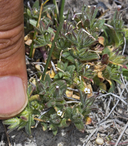notes The flowers here are quite small...my thumbnail is 15mm long, for scale reference. Found in the hundreds (perhaps thousands) growing along the middle portion of the open area ringing Spanish Lake (habitat image), southeast of Santa Rita Peak in the southern Diablo Range.
I've seen many instances of M. gracilis in many disparate locations and habitats, and am aware that it's renowned for its variability. But I've never seen a form with such a robust, tightly compact-tufted, densely-branched at base, wide and low-growing, mound-like form. All the plants here were quite uniform in this morphology. The nearest record of M. gracilis currently on CalFlora is a specimen collected by W.L. Jepson on San Benito Peak from May 13, 1907.
Edward L. Greene described seven species that are presently lumped under the single name Microsteris gracilis. The plants in this post correspond best to what Greene described as M. humilis here.
However, the form of the plants in this Spanish Lake population seem rather distinctive in that they are more densely compact and robust than those seen in the many SEINET images here for Phlox gracilis var. humilior (a synonym for Greene's M. humilis); or among the M. gracilis images nearest in form that are currently on CalPhotos (e.g. here, here, here, here, or here). In other words, these plants seems to represent the most extreme form I can find of this variant of the ''humilis'' variety within M. gracilis. Perhaps the nutrient-poor serpentine substrate at Spanish Lake is a significant factor in the distinctive form seen here? It would be interesting to see how these compare to the plants on San Benito Mountain and elsewhere in the Clear Creek serpentine block.
While the current Jepson treatment lumps all the forms within a single highly variable species, M. gracilis, there have been other workers besides Greene who've divided Microsteris into numerous subtaxa...though doing so appears to be discouraged by many contemporary taxonomists. The German botanist A. Brand published a 1907 work in which the plants here would correspond to the combination: Microsteris gracilis ssp. humilis var. micrantha subvar. congesta, based on the small calyces; glandular hairs; low growth form; and stems of little or no length. I'd be interested to see how the genus was circumscribed in the unpublished Claremont College thesis written by W. H. Kinch in 1956, entitled: ''A systematic study of Microsteris (Polemoniaceae)''.
